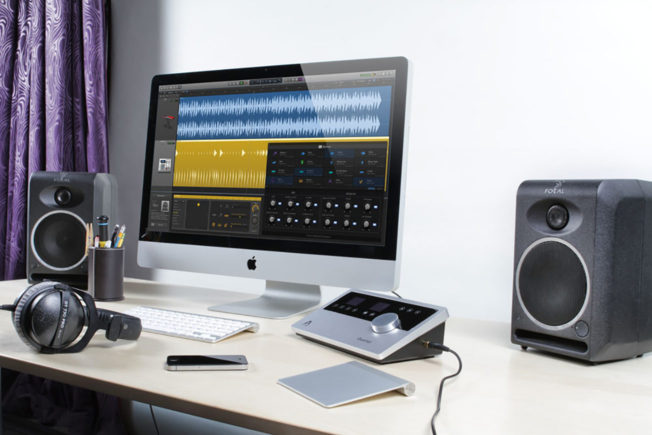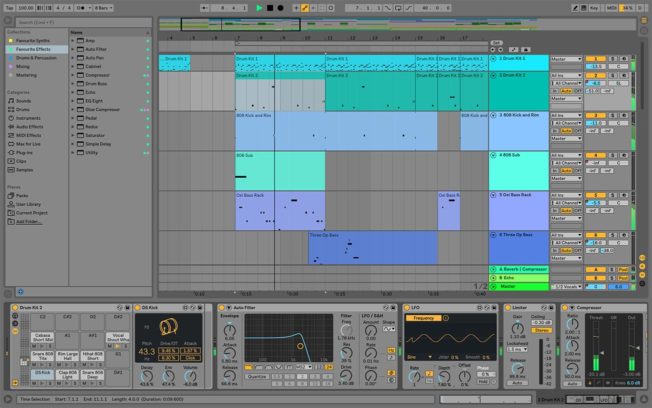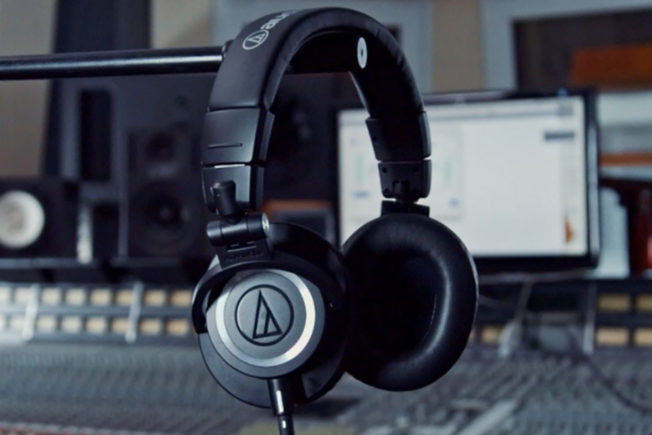Get your studio up and running with these four vital pieces of gear. This guide lists essential music production equipment for beginners.

Music Production Equipment for Beginners
Music production is more accessible than ever. Even on a budget, you can acquire the essential tools to create, edit, and mix music. This guide lists the top four things needed for anyone pursuing music production.
- Computer
- DAW
- Headphones
- Sounds/Plugins
Moreover, this list of music production equipment is created with the beginner in mind. Someone with absolutely no setup. If you have a setup, this list will still offer resources to help you get professional results. Remember, don’t buy based on what you can afford; instead, save up and buy based on what you need.
1. Computer

If music were a car race, the computer is the engine. It is the backbone of your entire digital music production setup. So, it’s crucial that you choose a stable computer that meets your needs and will handle anything you throw at it.
The top things to consider is the CPU speed, RAM, and storage space. It’s also essential to decide whether you want a laptop or desktop. Either way, try to buy a top of the line computer now or one you can upgrade later.
Digital audio production can be taxing on a computers CPU. It’s vital to choose a computer with the fastest, most powerful multi-core processor you can afford. This ensures you can run a DAW, multiple virtual instruments, effects, and anything else without issue.
RAM (Random Access Memory) determines how fast your computer can carry out tasks and run programs. 8 GB or more of RAM will run multiple music programs and plugins at once without issue.
Hard drive storage space is also crucial. Your sample libraries, instrument libraries, synth patches, saved projects, installed plugins, and more will use a lot of space. Ensure your internal hard drive has enough space for everything as you grow your setup. At least 500 GB should be good to get started. The two drive types to consider are Hard Disk Drives (HDD) and Solid State Drives (SSD). An SSD processes data and requests much faster than an HDD, but they are expensive.
Lastly, choose between a Mac or Microsft PC. Both types can handle all your music production needs if they meet the minimum requirements. Your DAW will be one major determining factor. If you plan on running Pro Tools X or GarageBand, then you will need a Mac. Compatibility is another factor. Some hardware devices like audio interfaces are only compatible with a Mac or PC. Check the specs!
The safest bet is a new(ish) apple computer for various reasons. If you are going PC, make sure the specs are as high or higher than the latest Apple model.
2. DAW

The Digital Audio Workstation or DAW has evolved from a simple recording medium to a complete studio inside your computer. It is the recording environment, instruments, sound design arena, and mixing platform all in one. Nowadays, they all come with high-quality plugins, sounds, and tools needed to create and edit music. There will be little you will need to buy after this initial purchase.
Your DAW will become a major part of your musical identity. Pick one that empowers your creative direction. The top ten DAWs for composing, producing, recording, mixing, and editing audio are:
- Ableton Live
- Logic Pro X
- Pro Tools
- Bitwig
- FL Studio
- Studio One
- Cubase
- Reason
- Digital Performer
- Sonar
They all can do any job, but some lend themselves to certain tasks better than others. Define what you want to do and then research which DAW would be best to accomplish that at a professional level.
3. Headphones

Accurately monitoring your sound is the next step to making dope music. If you start with headphones (rather than speakers), you don’t have to worry about the acoustics in your room right away. Eventually, you’ll want to invest in quality studio monitors and an audio interface.
Most headphones are made for consumers to enjoy music already created. They boost frequencies to make everything sound amazing all the time. These “colored” headphones are not so good for making music. You want to find a pair that is brutally honest and will allow you to hear a true representation of the audio. Studio headphones designed for music production are usually called “flat” because they don’t boost any frequencies. This accurate response will allow you to make songs that sound good on every pair of speakers. Lastly, you will spend at least $80 for something that can get the job done and last a few years.
[yuzo]
4. Sounds & Plugins

Nowadays, most DAWs come with everything you need to compose, edit, mix, and master your song. As you develop your skills, you will look at more specialized plugins and new sounds.
Audio Plugins
There is a massive selection of “third-party software” designed for various purposes. The two main plugin types used for music production are virtual instruments and audio effects. Instruments like synths and samplers generate sound, and the effects will help you manipulate those sounds.
With effects plugins, you will need high-quality equalizers, compressors, reverbs, delays, saturators, etc. Do some research to help you choose the right tool for the job. Moreover, consider looking into plugin bundles. They cost more than buying individual plugins. But, you get more for your money when buying bundles compared to the combined cost of buying each plugin individually. Also, some plugins like iZotope’s Ozone 8 come with at multiple plugin modules while also being useful for “mastering” (the final step in completing your song).
Sounds and Samples
When it comes to sounds, you will need all the essentials. Some main sounds to consider are drums, basses, pads, strings, pianos, FX, etc. There is a vast selection of sounds, samples, loops, and instrument patches available on the market. Furthermore, you can buy instruments that allow you to “trigger” these samples or buy the samples and drop them into whatever DAW you are using.
Also, sites like Splice.com offer a cloud platform for music creation, collaboration, and sharing. You can download one sample at a time or bundles of samples using a monthly subscription model. They also offer a “Rent-to-Own” plugin subscription.
Be careful not to get too much at a time. It takes me 10 hours to learn a plugin inside and out. I don’t get more than two or three a month to ensure that I get familiar with them all.
Final Advice
This list of essential music production equipment attempts to help people get to the finish line in the quickest, easiest way possible. If I had to do it all again, this is how I would start.